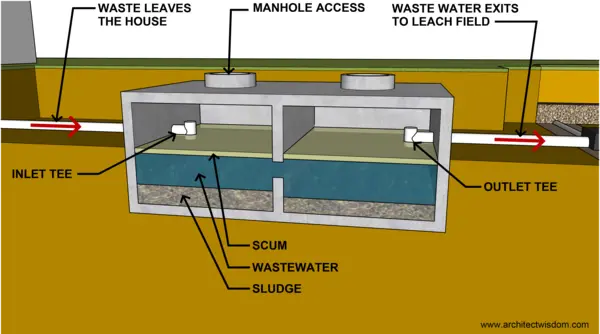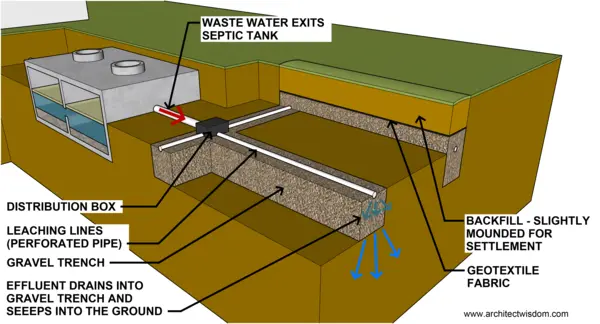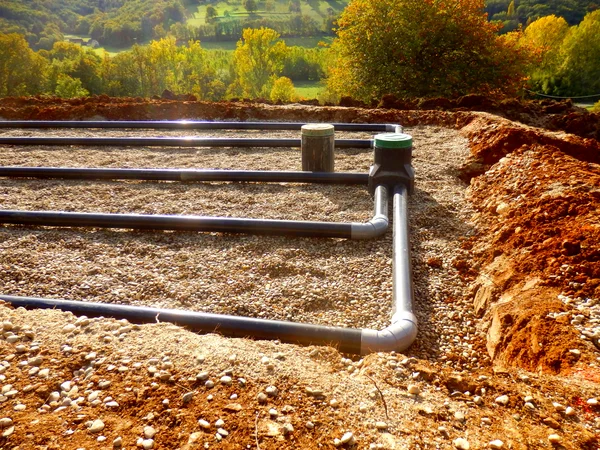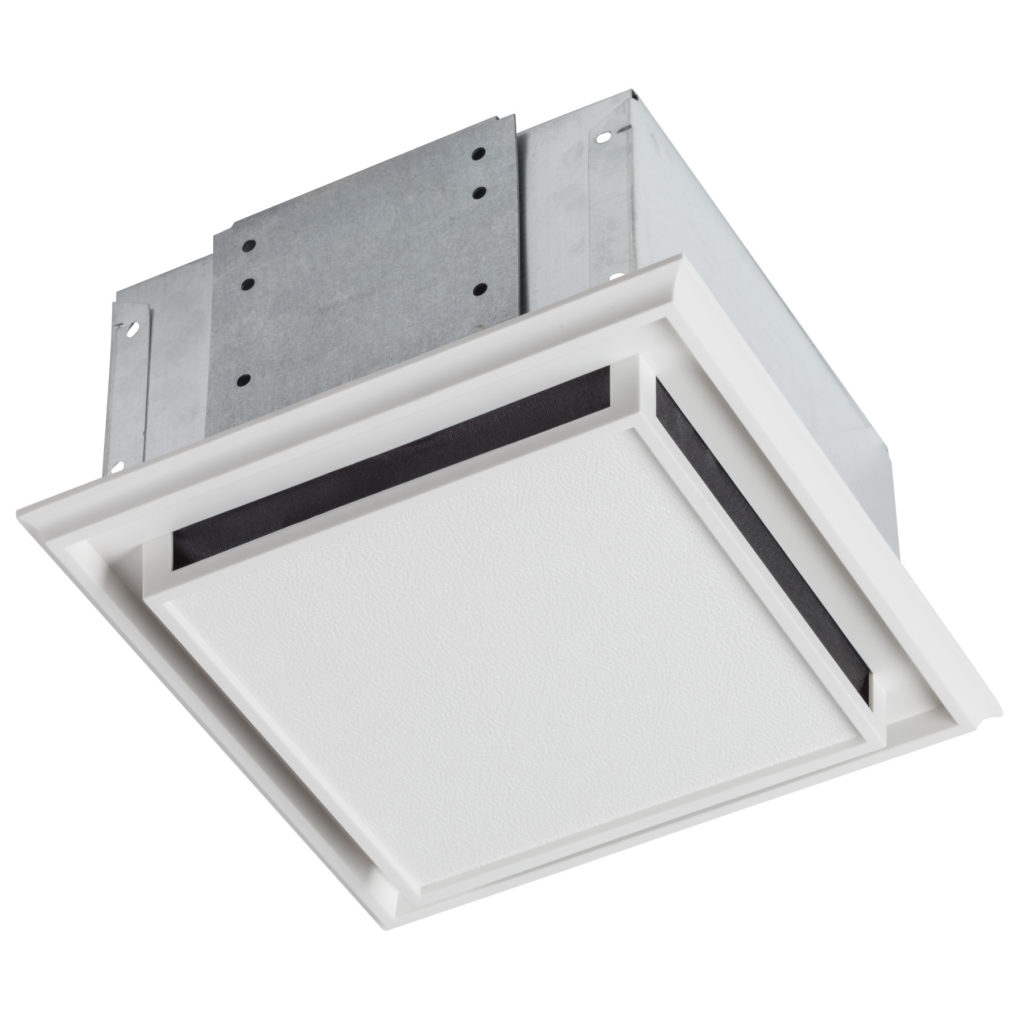An integral part of a modern septic system is the leach field. A leach field is designed to allow filtered waste material from your home to be safely absorbed across a large area of the ground. Without a leach field, the septic tank would quickly fill up with greywater and sewage and would need to be pumped out regularly.
Leach fields are only found at homes with a septic system. If you are connected to the city’s sewer lines in the street, you will not have a septic system.
- How does a leach field work as part of the septic system?
- What is a leach field?
- How are leaching fields configured?
- Leach field alternative: leach pits
- How big is a leach field?
- How long do leach fields last?
- What are the typical problems with a leach field?
- How to care for your drain field?
- What happens when a leach field is full?
- How do you unclog a leach field?
- What are the signs that your septic tank is full?
- Wrap up

How does a leach field work as part of the septic system?
When considering how a leach field works, we need to understand the overall septic system process.
- The wastewater flows from the home and into the septic tank.
- The bacteria inside the septic tank begin to break down the waste.
- Solid waste (the inorganic materials) sinks to the bottom of the septic tank. This is known as sludge. The oils, fats, and grease rise to the top of the septic tank and float. This is known as scum.
- The liquid effluent that doesn’t sink or float is allowed to flow through a filter and is distributed into a series of perforated pipes.
- These perforated pipes are installed in gravel beds or leaching chambers. As the effluent seeps out of the pipes, air is introduced, and the waste continues to break down.
- The effluent seeps into the surrounding earth and is re-introduced into the groundwater system. A small amount is used by the grass, surrounding plant life, or evaporates into the air.

What is a leach field?
The leach field is the portion of a septic system that consists of a network of pipes that are installed beneath the ground. There are two types of leach fields:
- Gravel systems
- Graveless systems
Most commonly, the pipes of a leach field are installed in gravel beds or trenches. This aids in the distribution of effluent into the ground as it leaves the perforated pipes. It also allows the effluent to mix with air so that aerobic bacteria can break down the effluent further.
Graveless systems have become more popular over the last few decades. Instead of using gravel installed in a trench, they use plastic interlocking leaching chambers. This creates a semi-circular “tunnel” that the perforated pipe is installed under and is often less expensive and quicker to install. A word of caution: in soils where there is a high percolation rate (water is absorbed quickly) this system may not give the effluent enough time to be broken down before working its way into the groundwater system.


With either option, the network of pipes allows wastewater (effluent) from the septic tank to mix with air where bacteria will further break down the waste until it becomes part of the groundwater system.
You may also hear a leach field called a drain field or tile drain field. These terms are typically used interchangeably.
The term leaching bed is often used interchangeably as well, but technically is a system where, instead of individual gravel trenches, the perforated pipes are installed in a continuous bed of gravel.

How are leaching fields configured?
For smaller installations, a single leach line might be used to distribute effluent from the septic tank, but these are usually limited to 100′ long and are often shorter.
More commonly, there will be a distribution box near the septic tank that will separate the waste evenly amongst several leach lines. These lines run parallel to one another with ample space between them for the waste and water to seep into the ground. Depending on your local codes, these pipes will be sitting in trenches with at least six feet between them.
When using a gravel system, the gravel trenches themselves will be 18″ to 36″ wide and around 30″ deep. They are typically located at least 12″ below the ground and the gravel is covered with a geotextile fabric to keep dirt from entering and clogging up the gravel.
The seepage pipes are typically 4″ diameter PVC piping. The trenches that the pipes are laid within for either type of system are required to slope away from the septic tank at least 1/8″ per foot.
Leach fields typically need to be located 100′ away from wells, 50′ away from streams, and a minimum of 10′ away from property lines. These distances may vary based on local building codes.
Leach field alternative: leach pits
Leach pits (or seepage pits) can be considered as an alternate to a leach field. They can be considered if the bottom of the pit is several feet (usually 24″) above the ground water table. They are useful when the property size is too small to accommodate a larger drainage field. They don’t, however, allow for the same amount of aerobic bacteria breakdown and therefore can lead to potentially higher contamination levels in the soil.
How big is a leach field?
The size of a leach field will vary based on the size of the home and/or the estimated water use of the building it is designed for. It also depends on the percolation rate of the soil it’s installed within. The percolation rate is essentially the rate at which water will be able to seep into the surrounding soil.
Sizing a leach field can be complicated and should be done by a professional, but I can give you an idea of the size. It’s overall shape may be determined by site constraints like the size of the property and setbacks from steep slopes, buildings, wells, or other site features. At an absolute max, leach lines will be 100′ long, but likely shorter. There will likely be several leaching lines at 6′ apart.
The following table can also be used to give you an idea of the size of your drainfield.
| Average percolation rate at drain tile depth (min/inch) | Area of trench bottom per bedroom (square feet) | Length of trench at 18″ wide | Length of trench at 24″ wide | Length of trench at 36″ wide |
| 5* | 125 | 84 | 63 | 42 |
| 10 | 165 | 110 | 83 | 55 |
| 15 | 190 | 127 | 95 | 64 |
| 20 | 215 | 144 | 108 | 72 |
| 30 | 250 | 167 | 125 | 84 |
| 45 | 300 | 200 | 150 | 100 |
| 50 | 315 | 210 | 158 | 105 |
| 60 | 340 | 227 | 170 | 113 |
| 70 | 360 | 240 | 180 | 120 |
| 80 | 380 | 254 | 190 | 127 |
| 90** | 400 | 267 | 200 | 134 |
Note: This is meant to be used for reference only. Check with local regulations.
For example, a 2 bedroom home with an average percolation rate of 20 and a 24″ wide trench, you would require 216 total feet of trench.
How long do leach fields last?
It will depend on what conditions your leach field is subjected to. However, you should be able to expect that a cared-for leach field that has been properly maintained should last fifty years or more.
What are the typical problems with a leach field?
Just like anything else, your drain field can develop problems over time. Here are a few issues you may face if your home has a drain field.
Inability to drain water because of rain
If your drain field soil becomes oversaturated, then it will no longer be able to absorb the effluent from your septic tank. If the ground becomes oversaturated, you will begin to notice some of the same common symptoms of a full septic tank: odors, slow drains within the house, or even a sewage backup in extreme cases.
Tree roots
It’s common for tree roots to grow over time and disrupt or damage your drain field. If you have trees nearby, you may need to remove them or have root barriers installed.
Parking / heavy loads on the drain field
If you’ve recently purchased your home, you may not know where your drain field is. Parking on your drain field can cause the soil to compact which will decrease absorption rates. Ensure that if you have a drain field installed or are buying a house, you find out exactly where your drain field is to prevent future problems.
Hydraulic overloading
This is when you are using more water than your system is designed to manage at one time. Your system was designed for a general amount of usage, so exceeding that amount can overload the system.
This might occur if you have guests at your home for an extended period of time, use multiple appliances at once (showers, dish washer, clothes washer, etc.) or house more people than the septic system was designed for.
Common symptoms of hydraulic overloading are the formation of puddles above the leach field, sewage backing up into your home, or the drains may drain slowly.
Biological overloading
This is caused when more chemicals are introduced into your septic system than it can handle. Your system has developed into a self-contained ecosystem. If you begin to use too many harsh cleaners and disinfectants, wash too much food down the garbage disposal or dump a lot of fat and grease down the drain, you are upsetting the balance that has come to be in your septic tank. This could cause your leach field to become clogged and for waste to take more time than usual to break down.
How to care for your drain field?
Pump your tank
Having your septic tank pumped every few years will help keep the inorganic material in the bottom of your tank to a minimum, which will allow your drain field to work much more efficiently.
Think about what goes down your drain
If you are flushing things down your toilet or down your kitchen sink that don’t belong there, then this will potentially cause harm to your leach field.
Avoid harsh chemicals
Chemicals can kill the good bacteria in your tank and begin to cause problems. If you need to use bleach, use it sparingly. If you are looking at using a drain cleaner, then you should try a plunger and a drain snake first. If that doesn’t work, then you should call a plumber.
What happens when a leach field is full?
A leach field doesn’t necessarily get “full”, but they could become clogged. This can cause your plumbing to back up. It can cause septic odors, septic leaking into your lawn, and contaminated groundwater.
If the ground is smelly or damp, it could be due to the tank not being pumped out recently enough. Or it could be due to the leach field being undersized or clogged, or that the system was installed incorrectly.
How do you unclog a leach field?
If your leach field is clogged, you can try to “shock” it. You can do so with a packet or concentrated liquid that is flushed down your toilet. The bacteria will help to break up the clog and relieve the problem. It would be best to use a shock packet once a month for regular usage, but you may need to do so more often to clear the clog.

There are other professional services that will clean the piping in the leach field using a pressure washing system. If a product like the one above doesn’t work and you’ve been properly maintaining your septic system, you should contact a professional.
What are the signs that your septic tank is full?
There are multiple symptoms that can indicate your septic tank might be full and needs to be pumped out. Pumping should only be needed every 2-5 years.
- Pooling water: If you notice a particular area or multiple areas of your yard are beginning to pool with water, especially if it has a sewage smell.
- Slow drains: If your drains are draining slowly, such as bathtubs and showers taking a longer than average for the water to empty them.
- Odors: If you begin to smell a sewage smell. This could be coming from anywhere on your property.
- An overly healthy lawn: If your property is green, even if you do not fertilize, that could signify a full septic tank. When your leach field or septic tank begins to back up, it fertilizes your yard without you knowing.
- Sewer backup: This will probably be the most obvious sign that your septic tank has problems. While you may be able to explain away the other issues, a sewer backup will let you know without a doubt that you are having septic problems.
Wrap up
If you are installing a new septic system, you should work with the local inspectors to ensure that all codes are being met. Septic systems are expensive to install and difficult to work on if something were to go wrong, so it’s important to get it right.
Sources:
Decentralized Systems Technology Fact Sheet
https://www.familyhandyman.com/project/how-a-septic-tank-works/





Thank you for explaining that pumping will only be required every two to five years. My sister is getting a septic tank installed on her property, and it’s made me curious to learn more about how this all works with maintaining it. I think I’ll have to talk about all of this more with her and see if I can gain some more insight after getting this overview.